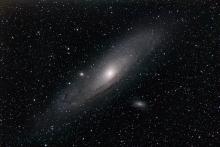Listen to today's episode of StarDate on the web the same day it airs in high-quality streaming audio without any extra ads or announcements. Choose a $8 one-month pass, or listen every day for a year for just $30.
You are here
Andromeda III
Most big spiral galaxies look calm and well ordered. Yet their histories are often just the opposite. The galaxies were built through a series of collisions, mergers, and close calls.
An example is M31, the Andromeda Galaxy. It’s our closest big galactic neighbor, at a distance of two-and-a-half million light-years. It’s high in the east in early evening, and looks like a small, faint, hazy patch of light.
Andromeda is a galactic giant. Its disk spans more than 200,000 light-years, and it contains hundreds of billions of stars. But it wasn’t born that way.
The original galaxy formed more than 10 billion years ago, from the merger of several smaller building blocks. There’s evidence that a few billion years later, it slammed into another large galaxy. That triggered an intense bout of star formation, giving birth to as many as a tenth of Andromeda’s present-day stars.
Since then, Andromeda has gobbled up several smaller galaxies. It’s also had encounters with a couple of nearby surviving galaxies, M32 and M33. M32 may have punched through Andromeda’s disk, while M33 may have sideswiped it. The encounters gave birth to more stars, pulled out ribbons of stars that reach far into space, and warped Andromeda’s rim.
Andromeda’s biggest galactic encounter is yet to come. In a few billion years, it will merge with our own galaxy, the Milky Way — giving birth to one of the most impressive galaxies in the universe.
Script by Damond Benningfield






